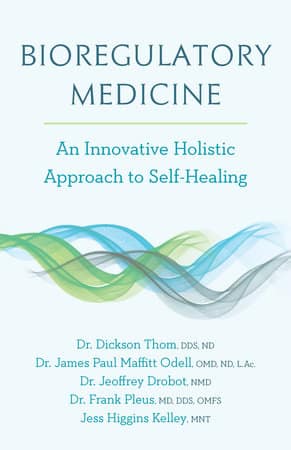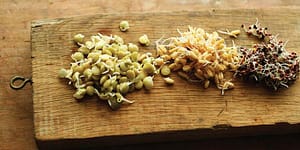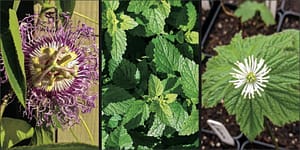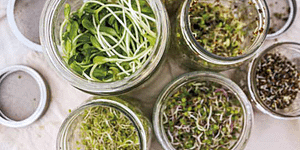Finding Balance for Your Body: Connecting the Dots

In recent years the concept of bioregulatory medicine has become increasingly popular throughout Europe. At its core is the notion that good health is a state of balance and optimal wellbeing, rather than the mere absence of disease and symptoms. To find that perfect state, bioregulatory medicine practitioners must remove whatever agents are blocking the healing process while also helping to restore the body’s innate ability to rehabilitate and regenerate. But to do that they must first correctly identify what the root cause of the imbalance is.
The following is an excerpt from Bioregulatory Medicine by Dr. Dickson Thom, Dr. James Paul Maffitt Odell, Dr. Jeoffrey Drobot, Dr. Frank Pleus, and Jess Higgins Kelley. It has been adapted for the web.
Like a log that has fallen across a flowing river, at the root of most illnesses are psycho-emotional and environmental toxic blockades that overwhelm the body’s regulatory systems. Consider a barrel that is filling with water. Every stressful event, every bite of toxic food, every exposure to mercury fillings is akin to pouring more water in that barrel. With every drop, more symptoms appear. Once the barrel is full it overflows into a disease state. But while everyone has a barrel, the influencing factors that fill each barrel are unique to each person.
We all have different life stressors, dietary habits, thought processes, past traumas, and environments. Each person, depending on their emotional type or miasm (inherited predispositions toward physical and/or mental illnesses or weaknesses), also adapts in his or her own way to these barrel-filling factors. To one person, getting stuck in traffic is maddening, and it fills their disease barrel a little bit. To another, traffic allows more relaxation time to listen to a favorite book on tape, and therefore it doesn’t add water to their barrel. How a person reacts—regulates—in response to causal factors is in part due to genetic predisposition, emotional/ mental characteristics, bioenergetic factors, social circumstances, and more. How full the barrel gets over the years plays an important role in the development of chronic illness. This is a process that might appear suddenly or insidiously, slowly mounting over months or even years. At the end of the day, both health and disease result from a complex interaction and reaction to physical, mental, emotional, environmental, genetic, spiritual, and social factors. A harmonious functioning and the ability to properly respond to all these dysregulating aspects is the blueprint to health.

Chronic disease occurs when a person has a lowered regulation capacity to such an extent that inherent healing forces are no longer able to react against disease-causing conditions with their normal and usual corrective efforts. Disease—quite simply—is a reduced regulation capacity. Regulation capacity is how well a person can adapt and react, and regulation logjams are what trigger or worsen chronic diseases. Bioregulatory medicine looks to remove the logjams and drain the barrel, all of which allow the resources for self-healing mechanisms to grow stronger, permitting self-healing to happen.
The terms self-heal and regenerate both refer to the self-repair forces inherent to humans. We know the body has the ability to regenerate, as our tissues regenerate all the time (think of a cut on your finger turning into a scab, then healing over completely). Over a life span, our body grows, develops, matures, and declines. Within this cycle of life, every one of the body’s cells and organs has its own regeneration cycle. Some cells are programmed to die after forty or so divisions. Every organ in the body has a regeneration cycle where old cells die and new cells are generated. Intestinal bacteria regenerate within several days, the intestinal wall within two weeks, and immune cells within four weeks. The liver possesses an extraordinary capacity to regenerate. As little as 25 percent of an original liver mass can regenerate back to its full size within six months. In general, the organs that do the most work encountering the outside world have the fastest regeneration rate. For example, the digestive lining and immune system cells have a far shorter life span than our bone, heart, and brain cells. Healing, therefore, depends on a tissue’s regeneration time.
The default state of the body is one of ceaseless regeneration. In fact, every atom and molecule of the entire human body is replaced every seven to ten years without us even thinking about it. This is a natural process that requires no medical intervention. However, in chronic and degenerative disease this renewal process goes haywire. In the case of cancer, cells become immortal and are constantly dividing and growing. In degenerative nerve diseases such as Alzheimer’s, cells of the nervous system degenerate instead of regenerate; they rot and die without replacement. Those following an allopathic medical track for neurodegenerative diseases end up on drugs such as dopamine antagonists and antiseizure medications that reduce the symptoms but don’t stop the root of the problem: nerve degeneration. A bioregulatory medicine treatment approach is in stark contrast. We know that there are several natural and nontoxic compounds with proven nerve-regenerative effects, including Huperzine, Apigenin, and lion’s mane mushroom, for example.1 These phytochemicals stimulate the regenerative process, promote quality and quantity of life, and shoot to cure.
The BioMed Patient Assessment

While the primary diagnostic tools of a bioregulatory medicine practitioner include those of any other physician—lab tests, blood work, X-rays, scans, scopes, histories, and physicals—the bioregulatory medicine practitioner also employs additional tools so they can examine each patient on multiple levels. These tools include, but are not limited to:
- Physical body examination and constitution analysis
- Dental examination and panoramic X-ray
- Organ biocommunication scans
- General blood work, including orthomolecular
- Genetic and SNP analysis testing
- Body composition analysis
- Dark field microscopy
- Hormone testing
- Heavy-metal testing (urine/blood/hair analysis)
- Intestinal flora and comprehensive stool analysis
- Food intolerances (IgA, IgG, IgG4)
- Heart rate variability (HRV)
- Contact regulation thermography (CRT)
Using the most technologically advanced diagnostic testing allows the bioregulatory medical provider to perform a core tenet: tolle causam, or identify and treat the cause. Bioregulatory medicine employs noninvasive diagnostic aids that view not only structural imbalances, but also functional, metabolic, genetic, regulatory, energetic, and psycho-emotional conditions. Hence, environmental toxins, lifestyle, social and professional influences, and ecological terrain and genetic information are all vital factors to evaluate. If a patient walks in with dermatitis, instead of simply prescribing a steroid cream, the bioregulatory medical practitioner will seek out the root cause of that inflammation—a food sensitivity, poor kidney or liver function, impaired oxygenation, weak lung activity, stress at work, or a combination thereof. The symptom is usually the end result of an imbalance in several systems. Lots of pushes off the beam, the barrel overflowing, the river clogged with logs.
Illness does not occur without a cause, and symptoms (nausea, vomiting, headache, rash, fever, etc.) are not the cause of illness. As we have discussed, symptoms are an expression of the body’s attempt to defend itself, to adapt and recover, and to heal. When symptoms are treated via palliation and suppression (allopathically), and the underlying causes are ignored, the patient might develop a more serious, chronic condition. Etiologies, or causes of disease, usually exist simultaneously. Disease develops in a causal chain, one begetting the other. Bioregulatory medical providers not only discover the primary cause of the illness, but also identify the weakest afflicted organ or system. This is called the causal chain—which is essentially a flow chart that represents the evolution of the pathological history of the patient, taking into account all the possible manifestations and the evolution of a disease.
1. S.Acosta et al.,“NT-020, a Natural Therapeutic Approach to Optimize Spatial Memory Performance and Increase Neural Progenitor Cell Proliferation and Decrease In ammation in the Aged Rat,” Rejuve- nation Research 13, no. 5 (2010): 581–88.
Recommended Reads
Taking Action: A Parent’s Guide to Health in the 21st Century
Recent Articles
Easy rainbow coleslaw! Transform your salad game with this colorful recipe. It is surprisingly packed with flavor and is a great addition to your repertoire.
Read MoreLearning how to ask questions that will elicit relevant information is as much an art form as creating an herbal formula. Follow this broad list as a starting point.
Read MoreWant to start your own medicinal herb garden? Passionflower, lemon balm, and goldenseal are great places to begin! These herbs are jam-packed with medicinal properties and easy to grow in a majority of climates.
Read MoreSprouts are easy to cultivate, mature quickly and pack a nutritional punch! You can make nutrient-rich sprouts from all kinds of edible seeds in your kitchen.
Read More








